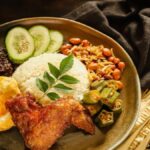Skip to content
Treasure Trove Workbook Answers
Topic
Passage – 1
(i) The white race in America is referred to as a free bird in the poem. The people of the white race enjoyed every type of luxuries whereas the caged bird which are referred to blacks could hardly move about.
(ii) In the first two lines the free bird is compared to who has favourable circumstances in life. The free bird float effortlessly on the downstream current of the wind and enjoy himself in the glow of orange rays of the sun.
(iii) The implied comparison in these lines is that circumstances are favourable to the free bird, and he easily and effortlessly enjoy the comforts and luxuries of life
(iv) Orange sun rays symbolize happiness, and freedom, comforts and luxuries of life.
(v) The free bird is the only bird to fly in the sky. The other
bird is caged. The free bird can fly wherever and whenever
it wants to fly as if he is the sole owner of the sky.
Passage – 2
(i) This stanza begins with ‘But’ because it presents a contrast to the first stanza. The first stanza describes a happy free bird. This stanza describes an unhappy bird in captivity.
(ii) The cage is narrow because the caged bird’s movements are restricted. The African-Americans were to stay in a restricted areas. The bars and rage means that the caged bird is angry, and his vision is restricted because of his anger.
(iii) The caged bird is in captivity. His feet are tied and his wings are clipped. His movement in the narrow cage is restricted. He is angry about his imprisonment but he is also helpless. In his anger he cannot think about anything except about his helplessness.
(iv) The caged bird is miserable and helpless. His wings are pared and his feet are bound. He can hardly move in his narrow cage. He is helpless. Now, in this a situation, he can do nothing but give expression to his feelings in a song.
(v) The poet writes about a free bird and a caged bird without a hint who the two represent. The poet is an African- American. In America the black race was enslaved by the white people. From the context it is obvious that the African- American are represented by the caged bird and the white
race by the free bird.
Passage – 3
(i) The caged bird is not only imprisonecl in a cage, its wings are also clipped and its feet are tied too. It is utterly helpless. Instinctively, it wants to fly free. But it does not know what it means.It can do nothing but opens his beak to sing about his plight and aspirations.
(ii) The caged bird has never known freedom. He has born enslaved. Though he does not know what freedom is, he feels he was not born to be kept in a cage. There is an instinctive urge about those ‘things unknown’ that makes him to open his beak and sing.
(iii) Fearful trill is the song sung by the caged bird. The caged bird sings it despite his physical enslavement. His spirit can not be enslaved. It is a song of revolt, and it’ causes fear, so it is called ‘fearful trill’
(iv) He is singing a song of freedom. It is a song of resentment against his slavery. He sings because there is no way to give expression to his feelings.
(v) The spirit of the caged birds cannot be suppressed. His song is a song that causes fear, and needs to be taken notice of. So the songs is heard far and near.
Passage – 4
(i) Another breeze refers to another opportunity that may help the greedy and lazy free bird to enjoy life without making any effort. The free bird thinks of another breeze because he is used to leading a life of ease.
(ii) The caged bird had aspirations and desires to achieve something. But on account of his captivity, he was helpless. His dreams were sniffed and stifled. He remained imprisoned in his cage which has turned into the grave of his dreams.
(iii) The caged bird represents the African-American race metaphorically. The African-Americans were enslaved by the white people. Every sort of restrictions were imposed on them. They were banned from walking in areas dominated by the white people. They could not use public transport
reserved for the white people. Thus they enjoyed neither freedom nor equality. This metaphorically is presented as clipped wings and bound feet and narrow cage.
(iv) The free birds has not to look for his livelihood. Fat worms are there on a lawn which are within easy reach of the free bird. He can eat them to his fill without having to make any effort to search for his food.
(v) The poem writes about two birds—a free bird and a caged bird. The two birds are poles apart. The free bird is free in every way. He claims the sky his own because the other bird is caged, and restrained from competiting with the free bird. The free bird finds .favourable breezes that will ‘lift’ and carry him without effort. But on the other hand the caged birds cannot even think of flying. His wings are clipped, his feet are bound, he is imprisoned in a cage. He is hungry and angry and helpless.






